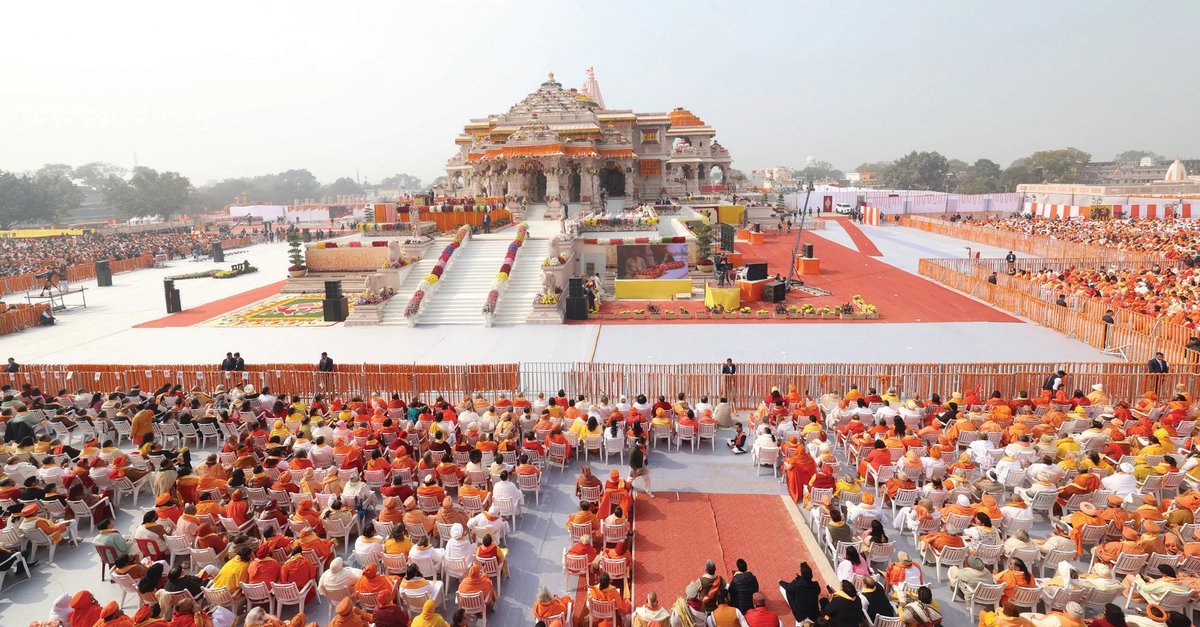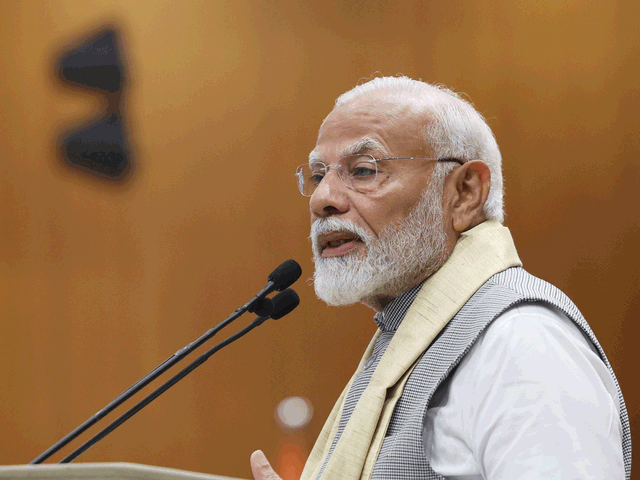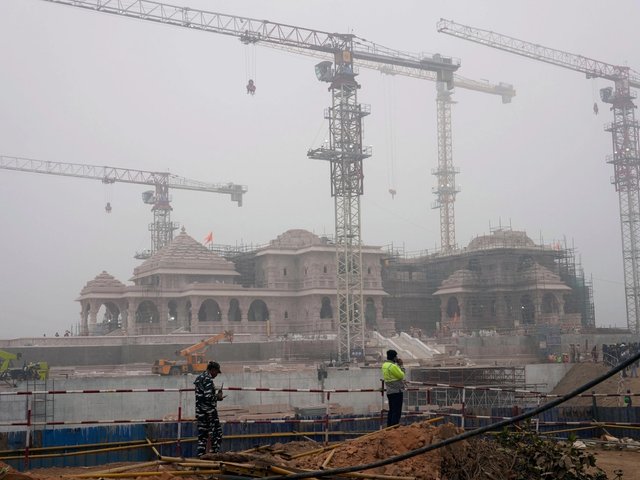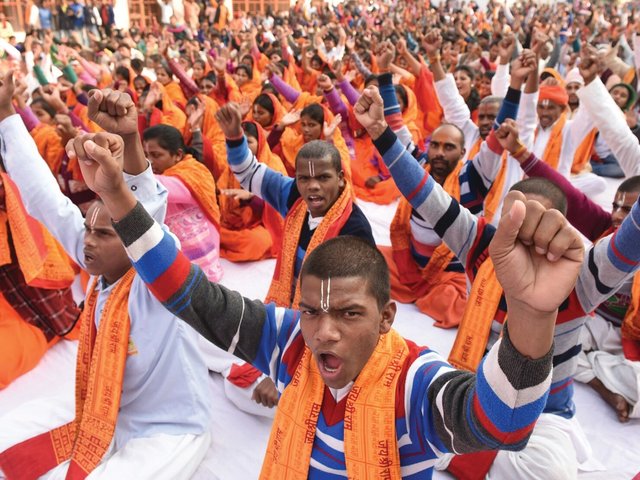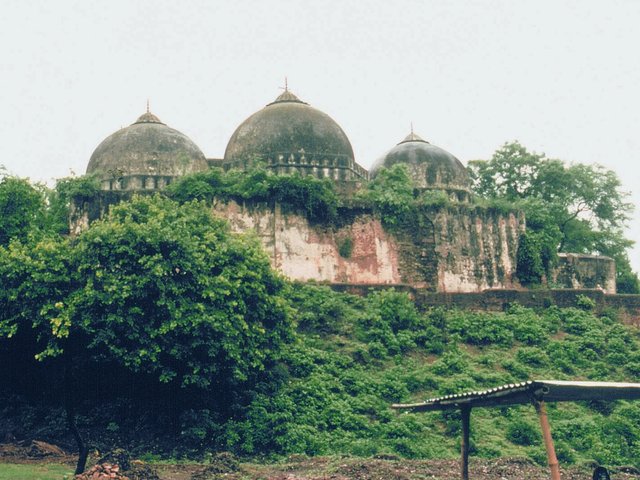Further redevelopment plans have been revealed for a museum dedicated to the Hindu deity Ram in Ayodhya, northern India. The Ram Katha Museum is managed and funded by the Ram Janmabhoomi Teertha Kshetra, the trust behind the nearby grand temple of Ram that was built at an estimated cost of $215m and was inaugurated to national fanfare exactly one year ago (22 January 2024).
The Ram temple complex was erected on the site of the former Babri mosque, which was demolished by a mob of Hindu extremists in December 1992. Many Hindu nationalists claim that the Babri Masjid was itself constructed atop a Hindu temple, on land that was the birthplace of Ram, despite several experts arguing that there is little evidence to support this. The legal battle about the disputed site culminated in November 2019, when the Supreme Court of India, the state’s apex judicial institution, delivered a controversial verdict that deemed the demolition of the mosque to be illegal, yet allotted the site to Hindu groups.
The Ram Katha Museum, which is scheduled to open to the public next year, promises to tell “a Hindutva version of the Ram story related to Ayodhya”, the noted curator and photographer Ram Rahman tells The Art Newspaper. It will also likely fail to acknowledge the violent history of the site it is founded on; at least 2,000 people, mostly Muslims, were killed in intercommunal riots across India sparked by the demolition.
The immersive Ram Katha Museum
The museum lies around four km from the Ram temple complex. Originally built in 2015, it is housed in a state government building that has been managed by the temple trust since 2023. According to Saurav Bhaik, the chief executive officer of Tagbin Services Private Limited, a Gurgaon-based immersive tech company that is developing the museum, the building was in “bad shape” and the museum was “static.” The existing curator, Sanjib Singh, is working with Tagbin to transform the space with the help of state-of-the-art technology, including AI, holograms and interactive 3D displays, to create an immersive experience. “Our concept is that we create Ramayana [the tale of Ram’s life] live because we have seen Ramayana, we have read it, but we have not experienced it,” Bhaik says, adding that working on the museum is a point of “prestige” for him.
The redeveloped museum will be spread across three floors and measure 40,000 sq ft. Bhaik expects its interiors to cost less than 1bn rupees (around $11.5m). According to the present plan, it will have over 15 galleries, and each of them will have a theme. For instance, Ram Darbar—Ram’s court—which will be shown through a hologram. The museum will reportedly also feature a small handful of artefacts unearthed by the Architectural Survey of India (ASI) during its excavations of the temple site.
A number of exhibits in the museum will be dedicated to the Ram Janmabhoomi movement—the journey to raze the mosque and create the temple. “There is a lot of stress on that,” Bhaik says. This movement was led by individuals affiliated with the far-right paramilitary organisation the Rashtriya Swayamsevak Sangh (RSS) and its political wing, the Bharatiya Janata Party (BJP) which now helms the country’s union government and has been repeatedly accused of discriminating against Muslims.
When asked if the museum will include criticisms of the Ram Janmabhoomi movement, such as the lack of evidence or the violence that led to loss of lives, Bhaik responded, “No, generally, we try to keep it free from controversies, because we need to understand [the people] who are coming there—they are coming for Ram, these are people with faith. So, this museum is not for critique, to come and pass that kind of a judgement. We will skip all of that part. We will try to tell the story which matters to the visitors, keeping the facts alive.” The facts, he says, come from their client, which is the temple trust.
Similarly, when asked if the museum will include the fact that the Supreme Court had called the demolition of the Babri mosque illegal, Bhaik pointed to an example of historical omission from the Pradhanmantri Sangrahalaya—the Prime Ministers’ Museum, a public museum in New Delhi opened in 2022, which Tagbin had worked on. He says that the museum, in discussing the assassination of Indira Gandhi, a former prime minister from the Congress party, on 31 October 1984, has chosen not to mention that her killers were Sikh. The video story of her assassination at the museum states that following Gandhi’s killing, “outraged mobs turned violent on the streets, leading to a human catastrophe,” but does not mention that the mobs were of Hindus, led mainly by Congress politicians, who killed more than 2,700 Sikhs in Delhi.
A complex past
The construction of the museum comes as another cultural initiative, formed to recognise and involve India’s Muslim community, struggles to come to fruition.
With its 2019 judgment, the Supreme Court had also allotted five acres of land to Muslims who formed a trust, the Indo-Islamic Cultural Foundation, to build a mosque, a museum and hospital facilities around 25 km away from the temple. The museum that the trust planned would be in memory of the freedom fighter Ahmadullah Shah, who had fought against the British Raj in Faizabad, as the Ayodhya district was formerly called. “We want to showcase this joint legacy of Hindu–Muslim, which is of shared struggle and of shared heritage,” Athar Hussain, the trust’s spokesperson, says.
However, none of these projects have taken off due to a “non-availability of funds”. Hussain points out that when the Supreme Court verdict came, no one was expecting five acres of land to be granted. “The funds that came for the Ram temple were more because of the socio-religious enthusiasm that was created in that moment,” he says, referring to the swell of donations to the The Ram Janmabhoomi Teertha Kshetra based on the belief that the location was sacrosanct as Ram was born there. “It wasn’t a similar situation within the Muslim community for this [new] mosque.”
Hussain says the Indo-Islamic Cultural Foundation is still hopeful for progress—it is now three years old, which makes it eligible for a license under the Foreign Contribution (Regulation) Act, which allows Indian organisations to secure funds from abroad. However, several human-rights and cultural organisations that rely on FCRA for funding have reportedly faced crackdowns by the ruling government in recent years.
A push for recognition
Bhaik has worked on multiple government projects and believes the special attention given to the new Ram Katha Museum is justified. “The thought process of the prime minister [Narendra Modi] is that we've been glorifying British culture for a very long time,” he says. “We have forgotten our 5,000-year culture. The present government’s ideology is to revive [a sense of] where we feel good about ourselves, where we Indians have our own identity—and that will come through when we showcase our culture, our history.”
He notes that there was no culture of visiting museums in India, due to many reasons, including a lack of visitor engagement. “We try to make [our museums] engaging and interactive so that at least we draw a crowd towards that and then they understand our culture and history,” he says.
However, critics of India’s ruling party and Hindu nationalism have often labelled this museological argument as part of a wider attempt to rewrite history to suit a Hindutva agenda. Upon opening, the Prime Minister's Museum was criticised for its perceived attempt to erase the legacy of Jawaharlal Nehru, India’s first prime minister, in whose former residence the museum is housed. Nehru was the leader of the Congress Party, the BJP's main opposition and a political party founded on principles of secularism. Until 2022, the Teen Murti Bhavan in Delhi contained only the Nehru Memorial Museum and Library. In April that year, the new museum came up complete with Tagbin’s holograms, augmented reality and virtual reality projects. In 2023, the government changed the name of the society that managed the complex from the Nehru Memorial Museum and Library Society to the Prime Ministers’ Museum and Library Society.
“See what happened with the Nehru Memorial Museum,” Rahman says. “The whole use of new technology is very seductive and now a generation has grown up using mobile phones—anything which is touchscreen or LED, large production, is attractive.” But he says “substance” must go into making a serious museum. “Spectacle doesn’t replace learning and proper research.”


